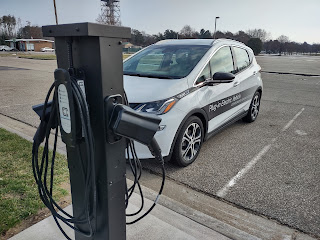Level 1 Charging - Is That Still Relevant?
I came across a newly installed Level 1 public charging station recently which seems like an anachronism in the day and age of 100+ kWh battery packs. In this case, it was a set of two 120V 20A Clipper Creek chargers which, based on the 80% NEC continuous use specification, only run at 16A (80% of 20A = 16A).
That puts the power output at just under 2 KW (120V * 16A = 1,920 Watts). The average light-duty EV has an efficiency of around 3.5 miles per kWh, so this station would add a whopping 7 miles of range per hour of charging. A 60 kWh battery pack in something like a Chevy Bolt EV would take 30 hours to fully charge from empty.
Why in the world would anyone want that?
The answer is quite simple: When the vehicle will be sitting and charging for a long time, it doesn't matter.What is the use case for that?
For the site host, there are significant cost and infrastructure savings associated with this approach. If an airport long-term parking lot is already charging you a per diem rate, the energy costs are insignificant, so they can install an inexpensive "dumb" (i.e. non-networked) station. In fact, they can install a whole bank of them at a very competitive price compared to networked Level 2 chargers that require recurring maintenance contracts and network fees.
How about airport long-term parking? If you're gone for 2-3 days, who cares whether your EV is done charging in 3 hours or 36 hours. The battery is still fully charged when you get back.
For the site host, there are significant cost and infrastructure savings associated with this approach. If an airport long-term parking lot is already charging you a per diem rate, the energy costs are insignificant, so they can install an inexpensive "dumb" (i.e. non-networked) station. In fact, they can install a whole bank of them at a very competitive price compared to networked Level 2 chargers that require recurring maintenance contracts and network fees.
Curious where this is? I made a quick (< 2 minute) video at the site location. Hint: It's my home town.
Where else do you think this approach makes sense?





Comments
Post a Comment
Feedback including suggestions or constructive criticism is welcome. Please note that abusive or offensive comments may be removed.